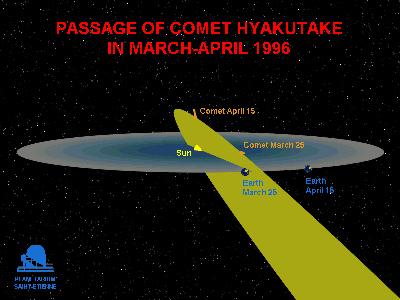Astronomy Picture of the Day
Discover the cosmos!
Each day a different image or photograph of our fascinating universe is
featured, along with a brief explanation written by a professional
astronomer.
March 14, 1996

Comet Hyakutake's Orbit
Credit:
Eric Frappa, Saint-Etienne Planetarium, France
Explanation:
Where did
Comet Hyakutake come from? The orbits of the Earth and this
brightening comet are shown in the above diagram. The blue disk is
bounded by the circular orbit of the Earth about the central Sun. The
comet's
path outlines the green shape. The shape of the comet's orbit
is close to a parabola. The comet has come in from the outer Solar System,
will pass near the Earth in late March, and pass near the Sun in late April.
Comet Hyakutake
will appear bright in late March because it is so close to the Earth, and
will again appear bright in late April because it is so close to the Sun.
In late March, the comet will be "north" of the Earth and so only visible
in the Northern hemisphere. Information about how to see Comet Hyakutake
is available from
many
University astronomy departments and planetaria.
Information:
The
Scale of the Universe Debate in April 1996
Tomorrow's picture: The McMath-Pierce Solar Observatory
| Archive
| Index
| Search
| Glossary
| Education
| About APOD |




Authors & editors:
Robert Nemiroff
(GMU) &
Jerry
Bonnell (USRA).
NASA Technical Rep.:
Sherri
Calvo.
Specific rights apply.
A service of:
LHEA
at
NASA/
GSFC




